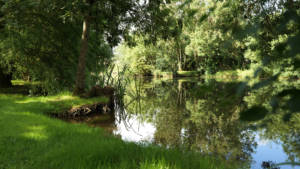16 November 2021

Nieul-sur-l’Autise is between the plains and marshland in the Marais Poitevin Regional Nature Park, and is classified a “Petite Cité de Caractère®” (charming little village), which is a label awarded to rural towns with remarkable heritage sites and a rich history. I contacted the Tourist Office to make sure I didn’t miss out on any of the must-sees. I made a note of all the places to see and picked up a leaflet before heading to Rives d’Autise, in the footsteps of Eleanor of Aquitaine!
A village on the water’s edge
From the Place du Forail, I begin my visit at the Parc du Vignaud, on the banks of the river Autise. Some people are relaxing on the water’s edge, others are reading in the shade or tree-hugging, which I’ve heard can be very beneficial. This vast 5-hectare space is ideal for enjoying a leisurely stroll and just taking your time. You can also come here for a picnic, to play games in the shade, or just walk barefoot across the fresh grass, a pleasant way to either begin or end your day. As well as being a pleasant place, the Domaine du Vignaud also provides group accommodation.

Le Vignaud and the House of Milling.
Near the park is the Maison de la Meunerie (house of milling), a visitor’s centre to learn about the miller’s trade, bearing the “Valeurs Parc Naturel Régional” label for the Marais poitevin. I didn’t hesitate a second before going to visit this place. The visitor’s tour takes us on an interactive discovery of the mill, cobbler’s workshop and the miller’s house, on the banks of the river. Thanks to Thierry, the village miller, this last water mill in Vendée was completely restored and recovered its original function. Every year, the Fête de La Meunerie is a festive and artistic event that showcases the ancient traditional trades. Nieul-sur-l’Autise certainly knows how to highlight and bring its history alive in the present day!
After this visit, I really wanted to taste the crêpes made using the flour from the local mill. There are two restaurants, the Auberge des Artistes with garden area, and the Crêperie du Moulin. I chose the latter to try the crêpes made using wheat flour and organic buckwheat flour from the mill in Nieul-sur-l’Autise. This restaurant uses local products, including organic eggs from a farm in Saint-Pierre-le-Vieux, goats’ cheese from local goat farms, as well as local vegetables, black pudding, honey, cider and beer.
A rich heritage and so many places to visit
I continued my exploration with the Abbey and the architecture characterised by the use of limestone. I take my time exploring the medieval garden. The visitor’s tour is an interactive one with modern museography to learn all about this place. I learn that the monks of Nieul-sur-l’Autise Abbey participated in the very first significant work in draining the marshland. The abbey was founded in 1068 and was granted the status of Royal Abbey by Eleanor of Aquitaine in 1141, who was Queen of France at the time. It is also possible to visit her house. The abbey has a single Romanesque cloister on the west side that is still standing and is a superb place to wander around, in the shade.

The Royal Abbey of Nieul sur l’Autise.
It’s time for me to go already. The abbey, mill and the Maison de la Meunerie are unmissable sights that I really enjoyed visiting, and this little town still has so much more up its sleeve, a hiking trail that runs alongside the river, musical opera-style evenings in the cloister of the abbey, etc. For fans of ancient monuments, nature lovers or those interested in old-fashioned professions, Nieul-sur-l’Autise has plenty for you to see and do!













